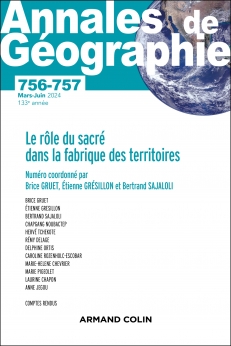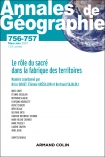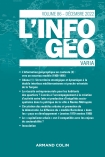
ANNALES DE GÉOGRAPHIE - N°756-757 (2-3/2024)
Pour acheter ce numéro, contactez-nous
Recevez les numéros de l'année en cours et accédez à l'intégralité des articles en ligne.
Cet article s’intéresse à la topographie sacrée dans l’agglomération de Lima-Callao (Pérou) à l’ère contemporaine. À partir de l’étude de trois formes de géosymboles qui marquent le paysage de la capitale péruvienne, l’article questionne le rôle du sacré et de son usage dans les modes d’habiter et d’organiser l’espace urbain marqué par la crise. Il montre que ces géosymboles ne remplissent pas seulement une fonction patrimoniale, mais qu’ils représentent également un enjeu de gouvernement urbain pour le collectif.
This paper focuses on the sacred topography in the urban area of Lima-Callao (Peru) in the contemporary era. Based on the study of three forms of geosymbols that mark the landscape of the Peruvian capital, this paper questions the role of the sacred and its use in the modes of inhabiting and organizing the urban space marked by crisis. It shows that these geosymbols not only fulfil a heritage function, but also represent an issue of urban government.

